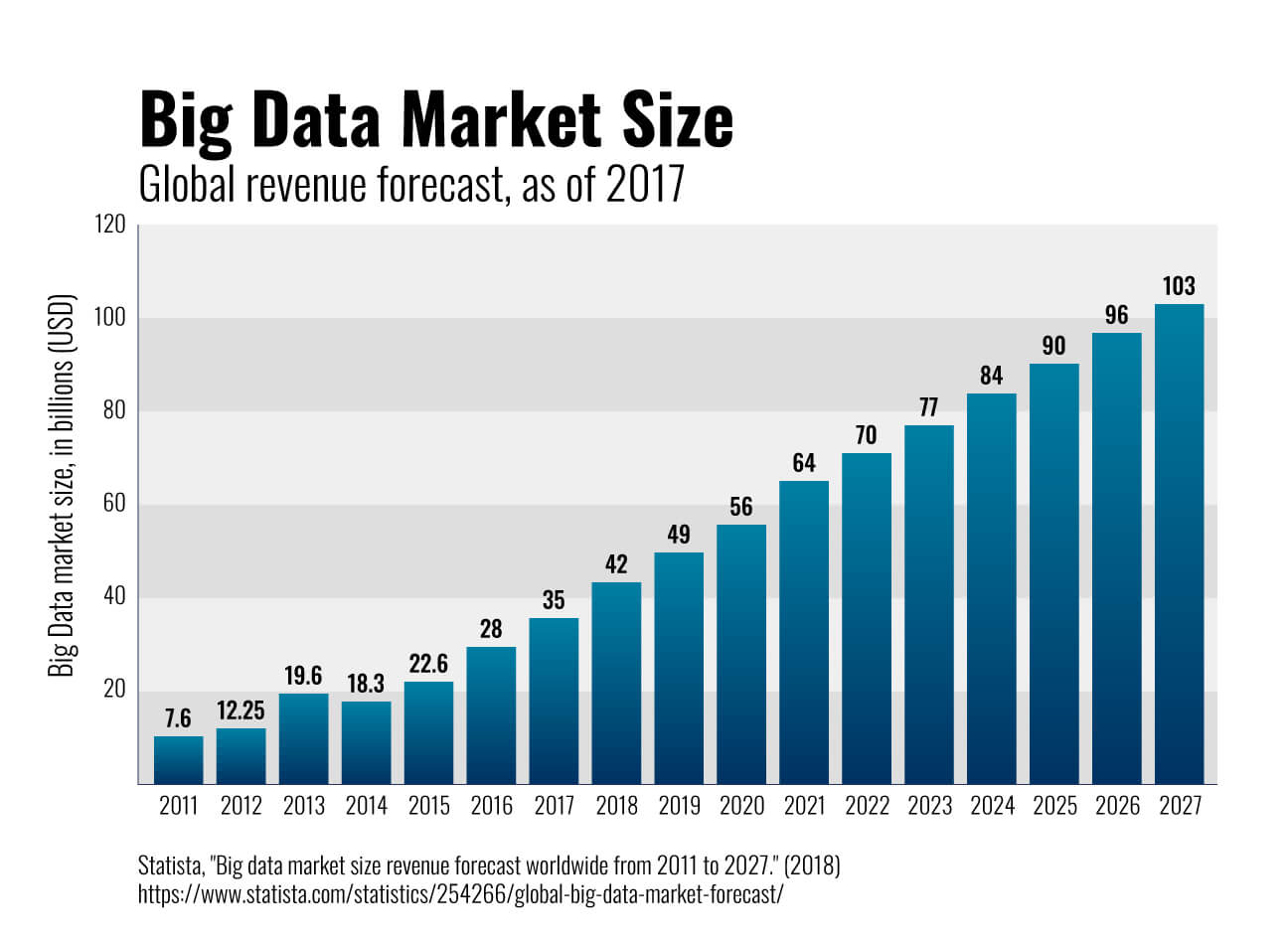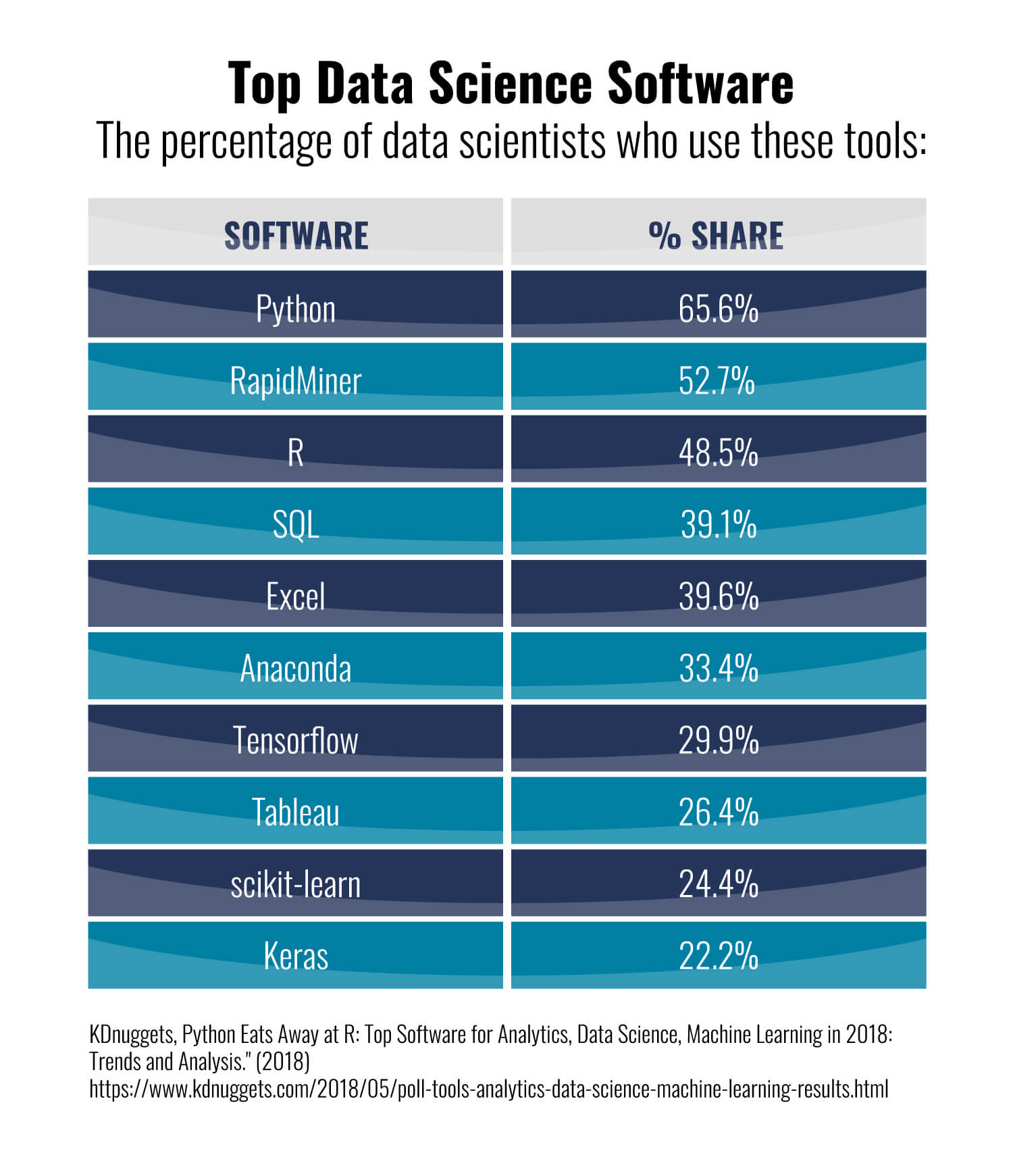Data Scientist Career Paths: All Your Options

Were you a math whiz in high school? Do you pore over Sudoku puzzles, enjoy patterns, or find yourself fascinated by the intricacies of tech? If so, you might want to consider a data scientist career path.
There is no singular definition for a data scientist. Straddling both the business and IT worlds data scientists employ statistics, mathematics, and computer science in their work with datasets. Unlike traditional analysts, most data scientists focus their efforts on programming, data preparation, and digital data visualization techniques. They use machine learning, deep learning, and pattern recognition to automate problem-solving techniques across various industries.
Despite its relative novelty, the data science career path has rapidly become one of the hottest professions in the tech world. In 2019, LinkedIn reported that data science was the #1 most promising career path in the U.S., with a 56 percent year-over-year growth rate. From 2016 to 2019, Glassdoor ranked data scientist as one of the 50 Best Jobs in America. In 2020, it sits at #3 on the list, with one of the highest average job satisfaction ratings among Glassdoor’s top careers.
Data science also has one of the most straightforward career advancement profiles out of any popular tech job. Over a few short years, analysts can vault from an entry-level position to more senior roles.
Data scientists are the most equipped to work with Big Data — a catchall term for the massive quantities of information generated by individuals that inundate businesses daily. Researchers for Statista note that the global Big Data market grew to $35 billion in 2017 and is expected to grow to a staggering $103 billion by 2027. The same researchers noted that as of November 2017, a full 45 percent of market research professionals reported using data analytics in their evaluations.

In short, data analytics has become a powerful means to capitalize on the new digital economy, understand consumer behavior, and disrupt industries. Now that nearly every facet of consumer behavior is trackable through the internet, data scientists are called upon to make the millions of lines of data gathered intelligible. Tech-conscious companies rely on the analysis of all this data to make better business decisions and better serve their consumers.
As you’ve likely gathered by now, data science is a great career path — but, admittedly, it can be challenging to know precisely where to begin. In this article, we’ll guide you through the steps you’ll need to take to get started.
Acquire the Skills and Training You Need
Intermediate Excel Functions
Excel is perhaps the most well-known tool used for organizing and analyzing data. Though the software isn’t quite as flashy as more advanced cloud-based platforms, Excel is still a reliable and versatile tool for data science professionals.
Excel maintains its reputation as one of the best programs for working with two-dimensional data and conducting advanced analytics. Data scientists also use Excel to automate behavior with macros and VBA (Visual Basic for Applications).
All those on a data science career path should be comfortable configuring pre-recorded sets of Excel commands and applying them to repetitive tasks. Those with development responsibilities should also be familiar with enabling scripts, creating novel macros, and encapsulating macro functions in VBA interfaces. In addition to Excel automation, data scientists also need to know how to create pivot tables for data processing. Pivot tables allow Excel users to summarize, sort, group, count, or otherwise quantify data.
Python Programming
It’s not an over-exaggeration to state that Python is the beating heart of data science. IEEE (Institute of Electrical and Electronics Engineers) Spectrum ranked Python as #1 on its list of the most popular programming languages in the data science industry in 2019, and in 2018, a widely-circulated KDNuggets poll found that 66 percent of data scientists primarily used Python. This remarkably flexible programming language has modular libraries pre-packaged with all the statistical, mathematical, and transformational functions a data scientist could ever need. To make the most of Python, it’s a good idea for data scientists to learn the standard style guidelines, which data structures to avoid, and familiarize themselves with the Python Package Index. Several data-type processes in Python also prove useful in the field, including lists, strings, tuples, sets, and dictionaries.

Many who go down the data science career path learn to extend the basic functionality of Python with third-party libraries. Jupyter Notebook, for example, is a popular framework for file management and execution. Meanwhile, NumPy is a fundamental package for scientific operations, and Pandas allows for better manipulation of high-level data structures.
Fundamental Statistics
Data scientists that understand the fundamental theories and techniques underlying mathematical-statistical analysis have a much better opportunity to grasp the meaning behind the data. Perhaps the most commonly used concept in statistical analysis is probability, which measures the likelihood of an event occurring or a characteristic being true. Analysts should be comfortable working with probability distributions, which represent all the possible values an experiment could yield on a distribution curve.
Other common concepts include dimensionality reduction, over- and under-sampling, and Bayesian statistics. All of these frameworks provide different means for data scientists to either work with or conceptualize their dataset on a broader level. Applied statistics can also be employed to reduce the amount of fine-grained data needed to complete specific operations.
Data Visualization
As the name suggests, data visualization is the practice of representing data findings in image-based formats. Visualization makes it much easier for analysts to grasp new concepts, illustrate data insights, and communicate effectively with individuals and coworkers outside the field.
By using visual analytics frameworks, data scientists can pictorially engage with millions of rows of data in seconds. Analysts should feel comfortable not only with rendering data into visual forms but also with pre-preparing data sets, compiling reports, and creating graphs.
Business Intelligence Software
Over the past decade, business intelligence has rapidly become one of the most vital fields to emerge out of the modern practice of digital analytics.
Business intelligence, or BI, empowers an organization to optimize its strategic decision-making processes by conducting company- or industry-wide data analyses. The term BI Systems refers to all the data gathering, storage, management, and transformations used to support a company’s decision-making efforts.
Common BI techniques include data mining, wherein the analyst sorts through large datasets and uses automation to identify emerging trends. Data preparation, automated reporting, and descriptive analytics are also essential processes in the field. Data scientists should feel comfortable interpreting historical data and applying insights to project future trends.
Databases
It is unfortunate that the term ‘database’ is often used as jargonized corporate-speak, especially when it is both much simpler and much more crucial than most people realize. Put simply, a database is a type of container that holds data in a structured and systematic way.
That said, not all databases are the same. There are two major types of data-storing containers (or languages) used by analysts: SQL and NoSQL.
SQL (Structured Query Language) is a programming language that allows developers to access, edit, add, or delete data. SQL is used to manage relational databases and perform unique operations on the data stored therein.
In contrast, NoSQL is a language meant for interacting with non-relational databases. In a NoSQL context, data entries aren’t required to have the same set and number of properties, which makes the data significantly easier to work with.
Regardless of the framework chosen, however, analysts should know how to work with large sets of data and navigate databases.
Find an Entry-Level Position
Entry-level data scientists are often required to have high proficiency with SQL, intermediate statistical computing experience, experience with data visualization, and excellent communication skills. Once you’ve acquired the skills you’ll need, your focus should be on crafting a knockout resume. At the end of the day, companies want to be confident that their favorite job candidate has the skills necessary to aid the business’s bottom line.
Narrow Your Focus
Data science is a broad term that encompasses a variety of niche fields. Mathematics, machine learning, cluster analysis, data mining, Big Data analytics, artificial intelligence — if there’s a way to quantify something, there’s a good chance it has its own field.
Consider a couple of competency areas you’re interested in and what tools you’d like to master. As you start on your data science career path, you are better off developing a solid handle on Python and SQL, for example, rather than jumping from framework to framework.
Are you having a hard time choosing? Get your hands dirty and dive into a small project that excites you. If you’re fascinated by the natural world, build a neural net that classifies images of diseased plants. Are you interested in buying a new home in an expensive area? Build a script that compiles the best posted real estate deals in real-time and then pushes them to your email. Don’t be afraid to play around with complex classification variables; factor in details like distance from the city center, the price per square foot, and projected future market value.
Over time, you’ll get a better idea of the challenges that excite you. As your competence grows, you’ll naturally find more opportunities to work with groups, build larger projects, and integrate flashier frameworks into your repertoire.
Find an Internship
Internships are the perfect way for new data scientists to get their foot in the industry’s door. Aside from gaining valuable experience, internships demonstrate that you have enthusiasm and initiative. As an intern, you’ll likely work with a team of professionals to solve problems in a corporate environment. Common tasks include conducting analyses, compiling reports, and working closely with your supervisors.
It’s also not uncommon for internships to result in full-time job offers — and even if they don’t, your supervisors can probably point you in the direction of companies interested in hiring full-time data scientists.
Create a Strong Portfolio
Build a portfolio that aligns with the skills you’ve mastered. Your portfolio should demonstrate expertise in a specific type of data, while also showing that you can perform well in a variety of domains. You’ll want to highlight projects that demonstrate proficiency in the top coding languages, such as Python, SQL, and R. Make sure your code looks clean and readable.
We recommend using GitHub, the most popular online version control platform used by developers. It’s also common to pair GitHub with a personal site that showcases the best of your work.
Progress to a Senior Role
Once you’ve landed that first entry-level role, it’s much easier to continue along the data scientist career path.
Large companies typically hire data scientists on three different levels: junior, senior, or principal. Most senior data scientists either progress through promotion or get referred to external companies upon leaving a position.
Entry-level workers are typically work extensively with structured datasets in Python. Junior developers are tasked with debugging, refactoring existing models, and testing new ideas in a small-scale environment.
More senior data scientists have a holistic view of the entire project. With three to five years of experience, these job candidates are comfortable taking projects to completion in both a programming and engineering environment.
Finally, principal data scientists have extensive experience working with a variety of different models. In addition to having a strong mathematical and engineering background, these candidates manage their teammates and present findings to company stakeholders.
Senior data scientists are typically required to have a Bachelor’s Degree in mathematics, computer science, economics, machine learning, or a quantitative field. However, several years of related work experience may substitute for undergraduate education.
Director and VP Roles
With enough time and experience, data scientists can enter into highly sought-after Director and VP roles. Directors are in charge of managing junior developers, ensuring proper execution of the team’s project, and negotiating with company executives.
Directors are an extremely valuable asset since they have a keen eye for strategy and well-developed tech skills; they leverage data science techniques to uncover company trends, insights, and emerging patterns.
Candidates for directorship roles sometimes hold a master’s or Ph.D. in statistics, machine learning, computer science, mathematics, or a comparable quantitative field. However, it’s possible to get promoted into the role without a formal educational background.
Directors are usually promoted from a senior-level position in a company where they have worked for five or more years. The competitive candidate will need proven success in leading their team through new data science projects and pioneered models, procedures, or techniques that demonstrably led to improved business performance.
Industries That Data Science Opens Doors For
Data science is in no way a static or restrictive field. Two similarly fresh-faced data scientists could end up working in industries as distinct as pet food supply and biochemical research. For many, the data scientist career progression is far from linear.
“Before, data science jobs were mostly constrained to the tech and finance sectors. Now, virtually every industry, from retail to manufacturing, is collecting data on their customers,” researcher Paul Petrone stated on LinkedIn’s Learning Blog. “That’s causing a surge of demand for data scientists who can best interpret all that data. And yet, since it’s a relatively new job, few professionals possess that skill set. Hence, most American cities, instead of just finance- and tech-heavy ones like San Francisco and New York, are short on data scientists.”
In the digital age, you’d be hard-pressed to find a single industry that wouldn’t benefit from on-boarding a data science team. Consider the below:
- Finance, the most numbers-driven industry in the world, requires data science for risk assessment, monitoring, identifying fraud, and providing customer analysis.
- Healthcare has become increasingly efficient through the adoption of pattern recognition technology, deep learning algorithms, and analytics.
- Energy industries lean on data scientists to identify cost-cutting measures, reduce risks, and optimize financial investments.
- In 2017, an Eye for Travel report found (PDF, 745 KB) that 51.5 percent of the surveyed travel organizations had a data science team with one to five professionals.
The work that data scientists do clearly matters, both in industries that are tech-savvy and in those that are traditionally less so.
Data Science: A Great Career Path
Without a doubt, data science has risen to prominence as one of the most rewarding career fields in the modern world. Data science is an invaluable part of what makes all our lives more livable; non-profit organizations, small companies, large corporate environments, and communities all benefit from having skilled teams of analysts. If you’re interested in taking a leap down the data science career path, start looking into online courses, data analytics boot camps, or other educational opportunities — doing so just might change your life for the better.

 Live Chat
Live Chat